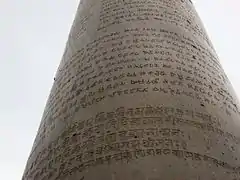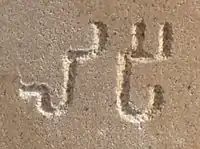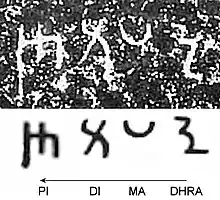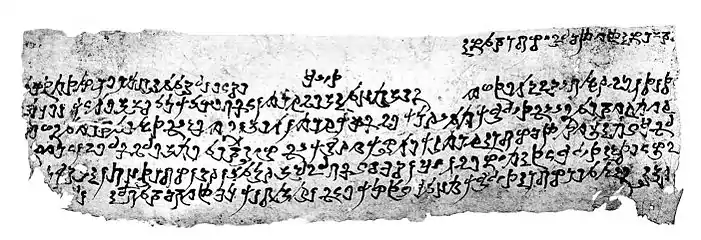Lipi
Lipi (Sanskrit: लिपि) means 'writing, letters, alphabet', and contextually refers to scripts, the art or manner of writing, or in modified form such as lipī (लिपी) to painting, decorating or anointing a surface to express something.[2][3]
The term lipi appears in multiple texts of Hinduism, Buddhism, and Jainism, some of which have been dated to the 1st millennium BCE. Section 3.2.21 of Pāṇini's Astadhyayi, composed before the mid 4th century BCE, for example, mentions lipi in the context of writing.[3][4][5] However, Panini does not describe or name the Sanskrit script. The Arthashastra, in section 1.2–5, asserts that lipi was a part of the education system in ancient India.[6]
According to Buddhist texts such as Lalitavistara Sūtra, young Siddhartha – the future Buddha – mastered philology and scripts at a school from Brahmin Lipikara and Deva Vidyasinha.[7][8] These texts list the lipi that the Buddha of ancient India knew as a child, and the list contains sixty-four scripts, though Salomon states that "the historical value of this list is however limited by several factors".[9] A version of this list of sixty-four ancient Indian scripts is found in the Chinese translation of an Indian Buddhist text, and this translation has been dated to 308 CE.[10]
The canonical texts of Jainism list eighteen lipi, with many names of writing scripts that do not appear in the Buddhist list of sixty-four lipi. The Jaina list of writing scripts in ancient India, states Buhler, is likely "far older" than the Buddhist list.[9]
Terminology
Lipi means 'script, writing, alphabet' both in Sanskrit and Pali.[11] A lipika or lipikara means 'scribe' or 'one who writes',[12] while lipijnana and lekhā means the 'science or art of writing'.[2][13] Related terms such as lekhā (लेखा, related to rekhā 'line') and likh (लिख) are found in Vedic[14][15] and post-Vedic[16] Sanskrit texts of Hinduism, as well as in regional languages such as the Pali texts of Buddhism.[17][18]
A term lip (लिप्) appears in verse 4.4.23 of the Brihadaranyaka Upanishad, verse 5.10.10 Chandogya Upanishad, verse 2 in Isha Upanishad and verse 5.11 in Katha Upanishad.[19][20] It means 'smear, stain'.[21] These are the early Upanishads and a part of Vedic literature of Hinduism.[20]

According to section 4.119 of the Unadisutras as now received, lipi is derived from the Sanskrit root lip.[23] The Unadisutras themselves certainly existed before the time of Pāṇini,[24][25] instances of later interpolations have been raised by Max Müller, although Müller does not discuss whether the sutra related to lipi was interpolated.[24] Salomon in 1995 remarked "The external testimony from literary and other sources on the use of writing in pre-Ashokan India is vague and inconclusive. Alleged evidence of pre-Mauryan writing has in the past been found by various scholars in such sources as later Vedic literature, the Pali canon, the early Sanskrit grammatical treatises of Pāṇini's and his successors, and the works of European classical historians. But all of these references are subject in varying degrees to chronological or interpretive problems." [26]
The Edicts of Ashoka (circa 250 BCE) use the word lipī. According to some authors, the word lipi, which is spelled dipi in the two Kharosthi versions of the rock edicts,[note 1] comes from the Old Persian prototype dipi (𐎮𐎡𐎱𐎡), which also means 'inscription', which is used for example by Darius I in his Behistun inscription.[note 2] E. Hultzsch, an epigraphist in the colonial British Empire, in his 1925 study on the Inscriptions of Asoka, considered the lip derivation untenable because of the two Kharosthi rock edict inscriptions from 3rd century BCE which use dipi instead of lipi. Hultzsch, as well as Sharma, state that this suggests a borrowing and diffusion of lipi from an Old Persian prototype dipi.[23][27][28]
Chronology
Some Indian traditions credit Brahma with inventing lipi, the scripts for writing.[29] Scholars such as Lallanji Gopal claim some ancient lipi such as the Brahmi script as used in the Indian texts, may have originated in Jainism.[30]
- "Lipi" in the Edicts of Ashoka


According to Harry Falk, scripts and the idea of writing can be traced to the Indus Valley civilization in the 3rd millennium BCE, but the term lipi in 1st millennium BCE Indian literature may be a loan word from the Achaemenid region, as a variant of Sumerian dub, turned to dipi or dipī.[32] Sanskrit lipi, states Falk, likely arose from a combination of foreign influences and indigenous inventions.[32] One evidence in favor of this view is that the form dipi was used in some of the Kharosthi-script edicts of Ashoka (3rd century BCE) in northwest India (in closest contact to Achaemenid culture) in parallel to lipi in other regions. As dipi was used in Old Persian Achaemenid inscriptions, Hultzsch suggested in 1925 that this proposal is "irresistible."[23] In his theory about the origin of the Brahmi script, Falk states that the early mention by Paṇini could mean that he was aware of writing scripts in West Asia around 500 BCE, and the Paṇini's mention of lipikara may possibly refer to non-Indian writers such as Aramaic scribes.[33]
- "Lipi" in Paṇini
Falk states that the single isolated mention of lipi by Paṇini, could mean that he was only aware of writing scripts from West Asia around 500 BCE.[33] According to Paul Griffiths, there is "no hard evidence of the use of Brahmi or Kharosthi script" in India before the Ashoka stone inscription, but the climate of India is such as that writing on other materials would not have survived for over 2,500 years. So, states Griffith, "the absence of early witnesses certainly doesn't mean there were none", but there is no "clear textual evidence of the use of writing in the Vedic corpus".[34]
- Opinions on origination
Kenneth Norman (a professor and the president of the Pali Text Society) suggests lipi in ancient India evolved over the long period of time like other cultures, that it is unlikely that a lipi was devised as a single complete writing system at one and the same time in the Maurya era. Norman suggests that it is even less likely that Brāhmī was invented during Ashoka's rule, starting from nothing, for the specific purpose of writing his inscriptions and understood all over South Asia.[35] Reviewing the recent archaeological discoveries relating to writing scripts in South Asia particularly Buddhism, Norman writes, "Support for this idea of pre-Ashoka development [of writing scripts] has been given very recently by the discovery of sherds at Anuradhapura in Sri Lanka, inscribed with small numbers of characters which seem to be Brahmi. These sherds have been dated, by both carbon 14 and thermo-luminescence dating, to pre-Ashokan times, perhaps as much as much as two centuries before Ashoka".[36]
Jack Goody similarly suggests that ancient India likely had a "very old culture of writing" along with its oral tradition of composing and transmitting knowledge, because the Vedic literature is too vast, consistent and complex to have been entirely created, memorized, accurately preserved and spread without a written system.[37][38] Walter Ong and John Hartley concur with Goody and share the same concerns about the theory that there may not have been any writing scripts during the Vedic age, given the quantity and quality of the Vedic literature.[39]
Falk disagrees with Goody, and suggests that it is a Western presumption and inability to imagine remarkably early scientific achievements such as Panini's grammar (5th to 4th century BCE), and the creation, preservation and wide distribution of the large corpus of the Brahmanic Vedic literature and the Buddhist canonical literature, without any writing scripts.[40] Johannes Bronkhorst (professor of Sanskrit and Indian studies) acknowledges that Falk is widely regarded as the definitive study on this subject, but disagrees and states, "Falk goes too far. It is fair to expect that we believe that Vedic memorisation — though without parallel in any other human society — has been able to preserve very long texts for many centuries without losing a syllable. (...) However, the oral composition of a work as complex as Pāṇini’s grammar is not only without parallel in other human cultures, it is without parallel in India itself. (...) It just will not do to state that our difficulty in conceiving any such thing is our problem".[41]
Richard Salomon, in a 1995 review, states that the lack of securely datable specimens of writing from pre-3rd century BCE period, coupled with chronological and interpretive problems of more ancient Indian texts, has made dating lipi and who influenced whom a controversial problem.[42]
Ancient Indian scripts
While historical evidence of scripts is found in the Indus Valley civilization relics, these remain undeciphered.[43] There has been a lack of similar historical evidence from the 2nd and early 1st millennium BCE, until the time of Ashoka where the 3rd-century BCE pillar edicts evidence the Brahmi script.[44] Late 20th-century archaeological studies combined with carbon dating techniques at Ujjain and other sites suggest that Brahmi script existed on the ancient Indian subcontinent as early as 450 BCE.[45]
Sri Lankan texts and inscriptions suggest that written script were in extensive use in ancient India, and had arrived in Sri Lanka by about 3rd century BCE.[46] While scholars agree that developed writing scripts existed and were in use by the second half of the 1st millennium BCE, the chronology and the origins of lipi in ancient India remain a controversial, difficult and unresolved scholarly topic.[47]
Indian and Chinese Buddhist texts
The tenth chapter of the Lalitavistara, named Lipisala samdarshana parivarta, lists the following 64 scripts as what Siddhartha (the Gautam Buddha) learnt as a child from his gurus in Vedic schools, a list that is found in both Indian Buddhist texts and its ancient Chinese translations:[1][7][8][note 3]
|
|
|
|
|
|
|
|
- Historicity
The historical value of this list of lipis is however limited, states Salomon, by several factors.[9] Although the Buddhist text with this list is ancient because it was translated into Chinese in 308 CE, the date of its actual composition is unknown. According to Salomon, the canonical texts of Buddhism may not be authentic and have interpolations. For example, he suggests that "Huna-lipi" or the script of the Huns listed as 23rd lipi in this list suggests that this part and the present form of the Buddhist text may have been fabricated in the 4th century CE.[9] Other than Brahmi and Kharosthi lipi mentioned in this list which can be positively identified with historic inscriptions, other writing scripts consist presumably of regional derivatives of Brahmi which cannot be specifically identified. Some names such as Naga-lipi and Yaksa-lipi appear fanciful, states Salomon, which raises suspicions about historicity of this section of the Buddhist canonical text.[9] However, adds Salomon, a simpler but shorter list of 18 lipis exist in the canonical texts of Jainism, an ancient Indian religion that competed with Buddhism and Hinduism. Buhler states that the Jaina lipi list is "in all probability considerably older" than the Buddhist list of 64 writing scripts in ancient India. The Jaina list does not have names that Salomon considers fanciful.[9]
The authenticity of Lalitavistara Sutra where this list appears and other canonical texts of Theravada and Mahayana Buddhist traditions, as well as "a complete denial of the existence of a historical Buddha", has been among the long debated questions in Buddhism scholarship.[48][49] Suspicions about the historicity of Lalitavistara, states EJ Thomas, are built upon presumptions which seek to reconstruct early history to fit certain theories and assumptions about what must have come first and what must have come later.[49]
Tibetan texts

The Magadhalipi mentioned in the Lalitavistara is discussed in the 7th-century Tibetan texts, in two forms: dBu-can (script with matra or the framing horizontal line drawn above each letter of the alphabet), and dBu-med (script without matra). The former is derived from the more ancient Lantsha script, while the latter derived from the Vartula script.[51] According to Cristina Scherrer-Schaub, Vartula means "rounded shape" and likely refers to the rounded letters of alphabet that were invented for various ancient Indian scripts. Scherrer-Schaub adds that the list of sixty-four scripts in the Buddhist text likely contains scripts that are fictional, with Devalipi and Nagalipi as examples.[50]
Jain texts
A smaller list of eighteen ancient Indian lipi is found in the Prakrit texts of Jainism (spelled as lipi sometimes[52]), such as the Pannavana Sutra (2nd century BCE) and the Samavayanga Sutra (3rd century BCE).[10][29] This list shares some names found in the Buddhist lists of ancient Indian scripts, but includes new names. The Jaina script list includes Brahmi at number 1, Kharosthi at number 4, but includes Javanaliya and others not found in the Buddhist lists.[10] Scholars such as Buhler state that the Jaina list of ancient Indian scripts is likely older than the Buddhist list, but still belonging to the second half of the 1st millennium BCE wherein Javanaliya probably is the same as one of the many Sanskrit scripts called Yavanani, which was derived from the Greek (Yavana) alphabet.[10] The Jaina canonical texts list the following writing scripts in ancient India:[53]
|
|
|
Devalipi and Devanagari
Given the similarity in the name, Devanagari may have roots in Devalipi, but Walter Maurer states that there is no verifiable evidence to prove that this is so.[54] According to Richard Salomon, the Brahmi script evolved to become both the north Indian scripts such as Devanagari, Punjabi, Gujarati and Bengali, as well as the south Indian scripts such as Tamil, Telugu, Kannada and Malayalam.[55]
See also
- Related topics
- Other similar topics
Notes
- For example, the first line of the first Edicts at Shahbazgarhi (or at Mansehra) reads: "(Ayam) Dhrama-dipi Devanapriyasa Raño likhapitu" ("This Dharma-Edicts was written by King Devanampriya" Inscriptions of Asoka. New Edition by E. Hultzsch (in Sanskrit). 1925. p. 51.
- For example Column IV, Line 89
- The names of scripts in this list varies by manuscript and Buddhist text, states Richard Salomon.[1]
References
- Richard Salomon (1998). Indian Epigraphy: A Guide to the Study of Inscriptions in Sanskrit, Prakrit, and the other Indo-Aryan Languages. Oxford University Press. pp. 8–10 with footnotes. ISBN 978-0-19-535666-3.
- Monier Monier-Williams (1899). Sanskrit-English Dictionary. Oxford University Press. pp. 902–903.
- Richard Salomon (1998). Indian Epigraphy: A Guide to the Study of Inscriptions in Sanskrit, Prakrit, and the other Indo-Aryan Languages. Oxford University Press. p. 11. ISBN 978-0-19-535666-3.
- Juhyung Rhi (2009). "On the Peripheries of Civilizations: The Evolution of a Visual Tradition in Gandhāra". Journal of Central Eurasian Studies. 1: 5, 1–13.
- Rita Sherma; Arvind Sharma (2008). Hermeneutics and Hindu Thought: Toward a Fusion of Horizons. Springer. p. 235. ISBN 978-1-4020-8192-7.
- Takao Hayashi (2008). Gavin Flood (ed.). The Blackwell Companion to Hinduism. John Wiley & Sons. p. 365. ISBN 978-0-470-99868-7.
- Lopon Nado (1982), The Development of Language in Bhutan, The Journal of the International Association of Buddhist Studies, Volume 5, Number 2, page 95, Quote: "Under different teachers, such as the Brahmin Lipikara and Deva Vidyasinha, he mastered Indian philology and scripts. According to Lalitavistara, there were as many as sixty-four scripts in India."
- Georg Bühler (1898). On the Origin of the Indian Brahma Alphabet. K.J. Trübner. pp. 6, 14–15, 23, 29., Quote: "(...) a passage of the Lalitavistara which describes the first visit of prince Siddhartha, the future Buddha, to the writing school..." (page 6); "In the account of prince Siddhartha's first visit to the writing school, extracted by Professor Terrien de la Couperie from the Chinese translation of the Lalitavistara of 308 AD, there occurs besides the mention of the sixty-four alphabets, known also from the printed Sanskrit text, the utterance of the master Visvamitra,...."
- Richard Salomon (1998). Indian Epigraphy: A Guide to the Study of Inscriptions in Sanskrit, Prakrit, and the other Indo-Aryan Languages. Oxford University Press. pp. 8–9 with footnotes. ISBN 978-0-19-535666-3.
- Richard Salomon (1998). Indian Epigraphy: A Guide to the Study of Inscriptions in Sanskrit, Prakrit, and the other Indo-Aryan Languages. Oxford University Press. p. 9. ISBN 978-0-19-535666-3.
- T. W. Rhys Davids; William Stede (1905). The Pali-English Dictionary. Asian Educational Services. p. 584. ISBN 978-81-206-1273-0.
- Richard Salomon (1998). Indian Epigraphy: A Guide to the Study of Inscriptions in Sanskrit, Prakrit, and the other Indo-Aryan Languages. Oxford University Press. p. 65. ISBN 978-0-19-535666-3.
- Sheldon Pollock (2006). The Language of the Gods in the World of Men: Sanskrit, Culture, and Power in Premodern India. University of California Press. p. 187. ISBN 978-0-520-93202-9.
- T. W. Rhys Davids; William Stede (1905). The Pali-English Dictionary. Asian Educational Services. p. 586. ISBN 978-81-206-1273-0.
- Maurice Bloomfield (2014, 2nd edition: 1964), A Vedic Concordance, Harvard University Press, ISBN 978-8124606650, page 832, Bloomfield mentions several mentions of Lekha in Vedic texts, e.g. section 1.5.3 of the Taittiriya Samhita.
- Stella Kramrisch; Raymond Burnier (1976). The Hindu Temple. Motilal Banarsidass. pp. 11 with footnote 22. ISBN 978-81-208-0223-0.
- Monier Monier-Williams (1899). Sanskrit-English Dictionary. Oxford University Press. p. 901.
- T. W. Rhys Davids; William Stede (1905). The Pali-English Dictionary. Asian Educational Services. pp. 576, 583–584. ISBN 978-81-206-1273-0.
- GA Jacob (1963), Upanishad Vakya Kosha – A Concordance of the Principal Upanishads and Bhagavad Gita, Motilal Banarsidass, page 802
- Patrick Olivelle (1998). The Early Upanishads: Annotated Text and Translation. Oxford University Press. pp. ix, 7–10, 126–127, 236–237, 398–399, 406–407. ISBN 978-0-19-535242-9.
- Monier Monier Williams, Lip, Sanskrit-English Dictionary with Etymology, Oxford University Press, page 902
- James Prinsep (1837). "Interpretation of the most ancient of inscriptions on the pillar called lat of Feroz Shah, near Delhi, and of the Allahabad, Radhia and Mattiah pillar, or lat inscriptions which agree therewith". Journal of the Asiatic Society. 6 (2): 600–609.
- Hultzsch, E. (1925). Corpus Inscriptionum Indicarum v. 1: Inscriptions of Asoka. Oxford: Clarendon Press. p. xlii.
- Friedrich Max Müller (1859). A History of Ancient Sanskrit Literature. Williams and Norgate. pp. 245–249.;
Braj B. Kachru; Yamuna Kachru; S. N. Sridhar (2008). Language in South Asia. Cambridge University Press. pp. 202–203. ISBN 978-1-139-46550-2. - Maurice Winternitz (1963). History of Indian Literature. Motilal Banarsidass. p. 476. ISBN 978-81-208-0056-4., Quote: "Such a list [rules of Unadisutras] existed from before the time of Panini, since he twice refers to it".
- Salomon, Richard, On The Origin Of The Early Indian Scripts: A Review Article. Journal of the American Oriental Society 115.2 (1995), 271–279
- Sharma, R. S. (2006). India's Ancient Past. Oxford University Press. p. 163. ISBN 9780199087860.
- "The word dipi appears in the Old Persian inscription of Darius I at Behistan (Column IV. 39) having the meaning inscription or "written document" in Congress, Indian History (2007). Proceedings – Indian History Congress. p. 90.
- Jao Tsung-i (1964), CHINESE SOURCES ON BRĀHMĪ AND KHAROṢṬHĪ, Annals of the Bhandarkar Oriental Research Institute, Vol. 45, No. 1/4 (1964), pages 39–47
- Lallanji Gopal (1978), DID BRĀHMĪ SCRIPT ORIGINATE WITH THE JAINS?, Annals of the Bhandarkar Oriental Research Institute, Vol. 58/59, pages 711–726
- Inscriptions of Asoka. New Edition by E. Hultzsch (in Sanskrit). 1925. pp. 56–57.
- Harry Falk (2009). "Foreign Terms In Sanskrit Pertaining To Writing". The Idea of Writing. Brill Academic. pp. 207–218. doi:10.1163/ej.9789004174467.i-396.66. ISBN 978-9047427926.
- Falk, Harry (1993). Schrift im alten Indien: ein Forschungsbericht mit Anmerkungen (in German). Gunter Narr Verlag. pp. 258–9.
- Griffiths, Paul J. (1999). Religious Reading: The Place of Reading in the Practice of Religion. Oxford University Press. p. 36. ISBN 9780195352207.
- Oskar von Hinüber (1989). Der Beginn der Schrift und frühe Schriftlichkeit in Indien. Akademie der Wissenschaften und der Literatur. pp. 241–245. ISBN 9783515056274. OCLC 22195130.
- Kenneth Roy Norman (2005). Buddhist Forum Volume V: Philological Approach to Buddhism. Routledge. pp. 67, 56–57, 65–73. ISBN 978-1-135-75154-8.
- Jack Goody (1987). The Interface Between the Written and the Oral. Cambridge University Press. pp. 110–124. ISBN 978-0-521-33794-6.
- Jack Goody (2010). Myth, Ritual and the Oral. Cambridge University Press. pp. 42–47, 65–81. ISBN 978-1-139-49303-1.
- Walter J. Ong; John Hartley (2012). Orality and Literacy: The Technologizing of the Word. Routledge. pp. 64–69. ISBN 978-0-415-53837-4.
- Annette Wilke; Oliver Moebus (2011). Sound and Communication: An Aesthetic Cultural History of Sanskrit Hinduism. Walter de Gruyter. pp. 182–183. ISBN 978-3-11-024003-0.
- Johannes Bronkhorst (2002), Literacy and Rationality in Ancient India, Asiatische Studien / Études Asiatiques, 56(4), pages 803–804, 797–831.
- Salomon, Richard (1995). "Review: On the Origin of the Early Indian Scripts". Journal of the American Oriental Society. 115 (2): 271–279. doi:10.2307/604670. JSTOR 604670.
- F. R. Allchin; George Erdosy (1995). The Archaeology of Early Historic South Asia: The Emergence of Cities and States. Cambridge University Press. pp. 62–63. ISBN 978-0-521-37695-2.
- Sheldon Pollock (2006). The Language of the Gods in the World of Men: Sanskrit, Culture, and Power in Premodern India. University of California Press. p. 10. ISBN 978-0-520-93202-9.
- F. R. Allchin; George Erdosy (1995). The Archaeology of Early Historic South Asia: The Emergence of Cities and States. Cambridge University Press. pp. 135–136, 147–148, 174–182, 209–215. ISBN 978-0-521-37695-2.
- The Origin of the Art of Writing in India and the Sri Lankan Experience Ariya Lagamuwa (2009), Rajarata University of Sri Lanka, page 2, Quote: "The drushtivada of Jains mentioned that Brahmi alphabet has 46 basic characters. Hiuen Tsiang states that the Brahmi alphabet remains intact over the generations and it has 47 characters. (...) According to their historical evidences, it is clear that the Indian alphabets including Brahmi have been widespread during the 3rd century BC".
- Salomon, Richard; von Hinüber, Oskar; Falk, Harry (1995). "On the Origin of the Early Indian Scripts". Journal of the American Oriental Society. 115 (2): 271–279. doi:10.2307/604670. JSTOR 604670.
- Alexander Wynne (2005), The Historical Authenticity of Early Buddhist Literature: A Critical Evaluation, Wiener Zeitschrift für die Kunde Südasiens / Vienna Journal of South Asian Studies, Vol. 49, pages 35–70
- EJ Thomas (1940), "The Lalitavistara and Sarvastivada", Indian Historical Quarterly, volume 16, number 2, pages 239–245
- Cristina Scherrer-Schaub (2012). Proceedings of the Tenth Seminar of the IATS, 2003. Volume 14: Old Tibetan Studies. BRILL. pp. 221–222 with footnote 18. ISBN 978-90-04-15517-6.
- Alaka Chattopadhyaya (1999). Atisa and Tibet: Life and Works of Dipamkara Srijnana in Relation to the History and Religion of Tibet with Tibetan Sources. Motilal Banarsidass. pp. 200–201, 451–452. ISBN 978-81-208-0928-4.
- Muni Nagraj (1986). Āgama Aura Tripiṭaka, Eka Anuśilana: Language and literature. Concept. pp. 223 with footnote 1. ISBN 978-81-7022-731-1.
- Richard Salomon (1998). Indian Epigraphy: A Guide to the Study of Inscriptions in Sanskrit, Prakrit, and the other Indo-Aryan Languages. Oxford University Press. p. 9 with footnote 9. ISBN 978-0-19-535666-3.
- Walter H Maurer (1976). "On the Name Devanāgarī". Journal of the American Oriental Society. 96 (1): 101–104. doi:10.2307/599893. JSTOR 599893.
- Richard Salomon (1998). Indian Epigraphy: A Guide to the Study of Inscriptions in Sanskrit, Prakrit, and the other Indo-Aryan Languages. Oxford University Press. pp. 33, 31–39. ISBN 978-0-19-535666-3.
External links
- Lipi in ancient India (in Chinese), 佉留文字與四十二字門, 正觀雜誌 (1999)
- The Lalitavistara (The play in full), translated by the Dharmachakra Translation Committee, pages 91–92
- Candravyakarana – Deciphering an arrowhead Indian script, Albrecht Hanisch (2009), Nagoya University
- The Vartula or Vaivarta Lipi, Sita R Roy (1967)

